Genus is a taxonomic rank used in the biological classification of living and fossil organisms as well as viruses. In the hierarchy of biological classification, genus comes above species and below family. In binomial nomenclature, the genus name forms the first part of the binomial species name for each species within the genus.

Sea pens are colonial marine cnidarians belonging to the order Pennatulacea. There are 14 families within the order; 35 extant genera, and it is estimated that of 450 described species, around 200 are valid. Sea pens have a cosmopolitan distribution, being found in tropical and temperate waters worldwide, as well as from the intertidal to depths of more than 6100 m. Sea pens are grouped with the octocorals, together with sea whips (gorgonians).
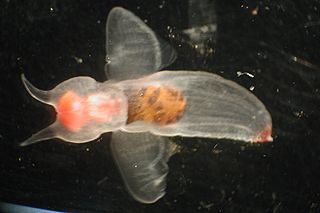
Clione is a genus of small floating sea slugs, pelagic marine gastropod mollusks in the family Clionidae, the sea angels.

The Valvifera are marine isopod crustaceans. Valviferans are distinguished, however, by the flat, valve-like uropods which hinge laterally and fold inward beneath the rear part of their bodies, covering the pleopods. Some species are omnivorous, and serve as effective scavengers in the economy of the sea. Eleven families are recognised:
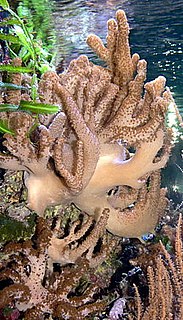
Alcyonacea, or soft corals, are an order of corals. In addition to the fleshy soft corals, the order Alcyonacea now contains all species previously known as "gorgonian corals", that produce a more or less hard skeleton, though quite different from "true" corals (Scleractinia). These can be found in suborders Holaxonia, Scleraxonia, and Stolonifera. They are sessile colonial cnidarians that are found throughout the oceans of the world, especially in the deep sea, polar waters, tropics and subtropics. Common names for subsets of this order are sea fans and sea whips; others are similar to the sea pens of related order Pennatulacea. Individual tiny polyps form colonies that are normally erect, flattened, branching, and reminiscent of a fan. Others may be whiplike, bushy, or even encrusting. A colony can be several feet high and across, but only a few inches thick. They may be brightly coloured, often purple, red, or yellow. Photosynthetic gorgonians can be successfully kept in captive aquaria.

The Stichopodidae are a family of sea cucumbers, part of the order Synallactida.

A micromollusk is a shelled mollusk which is extremely small, even at full adult size. The word is usually, but not exclusively, applied to marine mollusks, although in addition, numerous species of land snails and freshwater mollusks also reach adult size at very small dimensions.

Turbinellidae are a family of sea snails, marine gastropod mollusks in the clade Neogastropoda. Members of this family are predators.

Neverita is a genus of medium-sized to large sea snails, marine gastropod molluscs in the family Naticidae, the moon snails

Odostomia is the most speciose genus of minute sea snails, pyramidellid gastropod mollusks. This genus is placed in the family Pyramidellidae in the subfamily Odostomiinae. There are several hundred species in this diverse genus
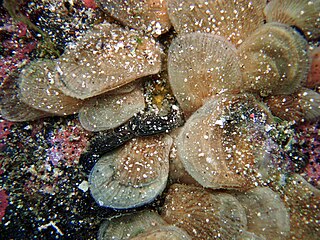
Isognomon is a genus of marine bivalve mollusks which is related to the pearl oysters.
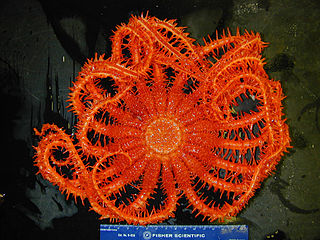
The Brisingids are deep-sea-dwelling starfish in the order Brisingida.
Axelella is a genus of sea snails, marine gastropod mollusks in the family Cancellariidae, the nutmeg snails.
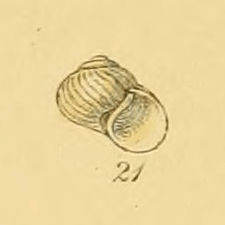
Moelleria is a genus of sea snails, marine gastropod mollusks in the family Colloniidae.
Scaliola is a genus of sea snails, marine gastropod mollusks in the family Scaliolidae.

Tenagodus is a genus of sea snails, marine gastropod mollusks in the family Siliquariidae.

Favia is a genus of reef-building stony corals in the family Mussidae. Members of the genus are massive or thickly encrusting colonial corals, either dome-shaped or flat, and a few are foliaceous. There is a great diversity of form even among individuals of the same species. The corallites project slightly above the surface of the coral and each has its own wall. In most species, the corallites are plocoid and in some, monocentric. The septa and costae linked to the corallite wall are well developed and covered by fine teeth. The polyps only extend and feed during the night. Each one has a small number of tapering tentacles which often have a darker coloured tip; these are called stinger tentacles, or sweeper tentacles. They use these to sweep the water to see if any other coral is in its area; if so, then they begin to sting the other coral. This is commonly known as coral war. Each coral is trying to make sure it has enough room around it so it can continue to grow and have more surface area for its offspring. The columella is parietal and spongy, and there are vesicles on both the endotheca and exotheca. Members of this genus are widespread in both the Atlantic Ocean and the Indo-Pacific.
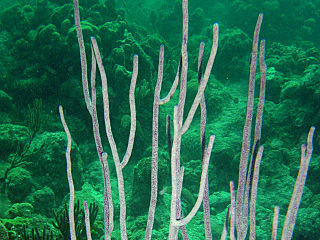
Ellisella, commonly known as sea whip, is a genus of soft coral in the family Ellisellidae.

Solecurtus is a genus of saltwater clam, a marine bivalve molluscs in the family Solecurtidae.

Funiculina quadrangularis, commonly known as tall sea pen, is an uncommon cold water coral within the Family Funiculinidae. It is named tall sea pen because it looks like a quill sticking in the bottom of the sea. It forms habitat for several key crustacean species.

















